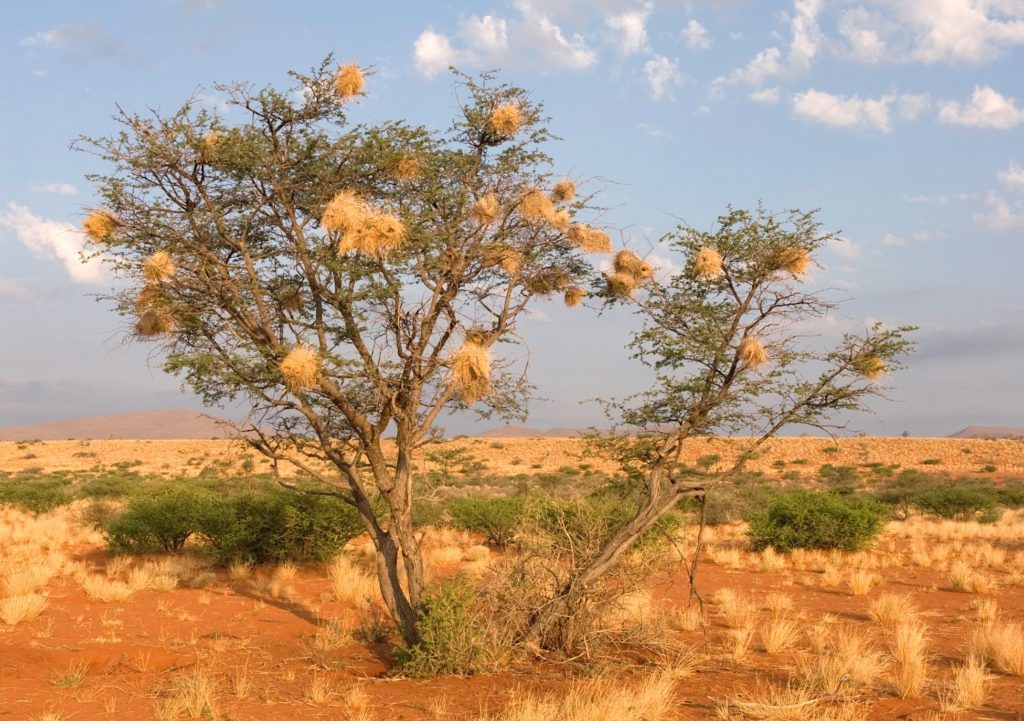Birds of a feather really do flock together, or build together as the case may be, incorporating their unique architectural style when building nests, according to new international research led by the University of St Andrews.
The new research, published in Science, reveals that - like humans - birds cooperate to build complex structures with culture-specific architectural styles.
Led by Dr Maria Tello-Ramos and Professor Susan Healy, from the School of Biology at St Andrews, the international team of researchers, in collaboration with the University of Exeter and the University of Alberta, measured the structures (nests and roosts) built by 43 groups of white-browed sparrow weaver in Tswalu Kalahari, in the Kalahari Desert, northern South Africa, to understand the unique building styles between different social groups of birds.
Dr Andy Young, leader of the University of Exeter's long-term research on these Kalahari weaver birds, said: "The architectural differences among sparrow weaver groups are fascinating as they are clearly visible in the field, even between neighbouring social groups.
"Our study documents these differences in weaving style and then probes the mechanisms by which they arise."
Trees with structures built by white-browed sparrow weavers can be seen across southern Africa.
The white-browed sparrow weaver is a social bird, living in family groups in their unique structures.
Within the social make-up of the groups, there will be one dominant male and one dominant female who reproduce together, and their offspring stay to help their parents raise the offspring that follow.
Occasionally birds from other families will join.
The groups are highly territorial and may keep the same territory for up to a decade.
Within their territory these cooperatively breeding birds build two types of structures: one nest in which the dominant female lays her eggs and multiple roosts for sleeping overnight.
Each of these roosts holds only one bird.
Nests and roosts are shaped like an upside-down "U" and are made from grass.
One arm of the U is the entrance tube, and the other is the exit tube.
When sleeping in a roost, a bird flies in via the entrance tube and perches on the flat area between the two tubes.
Each family group builds at least three times as many roosts as there are birds in the group.

The team studied groups of white-browed sparrow weavers over a three-year period to understand the unique differences between each structure.
It was found that structures built by neighbouring groups of birds varied in style and size from one another.
Some groups build structures that have long tubes, while other groups consistently build structures with short tubes, yet others will have one tube long and the other shorter.
Groups that are closer to each other did not build structures that were more similar.
Groups in territories that experience similar weather conditions did not build similar structures.
None of the other features the team looked at, such as the size of the birds in a group, the height of trees in which they built, or the patterns of genetic relatedness between groups explained the differences in the "architectural styles" of the different groups.
Dr Tello-Ramos said: "Because birds in a group continue to build structures of the same architectural styles, our research showed that even when new birds join a group, and despite all members of a group cooperating to build the structures together, distinctive architectural styles have appeared in the different groups of this bird species."
Professor Healy added: "Much like birdsong, migrating routes and foraging behaviours, cultural processes might play a role in explaining building behaviour in birds, making it easy to identify species from their architectural styles.
"The next step is to discover how birds can coordinate together to build coherent structures, and then whether they copy or teach each other how to build a specific structure.
"The implications of this might suggest that humans, once upon a time, learned how to build from watching birds."






